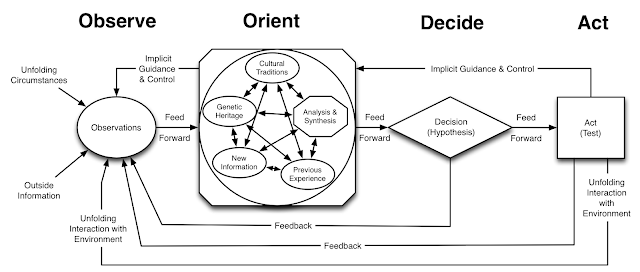 |
| The final version of the image, after several iterations through the OODA decision loop |
I created the image above using the OODA loop, a decision model originally created to help fighter pilots make better decisions in combat. The OODA loop can help you become a better photographer, the same way it has helped me.
The OODA loop was originally created by U.S. Air force Colonel John Boyd. Boyd, known as 40 Second Boyd, had a standing bet to down any opponent in 40 seconds or less. He never lost.
Later in life, Boyd became known as a master strategist. The OODA loop was incorporated in his strategic framework, Maneuver Conflict. From there, the OODA loop, often in a hopelessly distorted form, spread to business strategy. Bill Dettmer wrote a business strategy book about it, and that is where I found it, several years ago.
I won't go into the details of the OODA loop here. I have written a book about it (Tempo!, available in Swedish only), blogged about it, and made videos about it.
I won't go into the details of the OODA loop here. I have written a book about it (Tempo!, available in Swedish only), blogged about it, and made videos about it.
What I will do here is show how I applied it to identify an opportunity, and turn it into a good photo.
I was just about to cross a bridge when I saw two or three people climbing up the banks of a frozen canal. Nearby them, something glinted on the ice.
This was my first iteration through the OODA loop: I observed movement in a location where my orientation process told me there normally is none. I decided to have a closer look, and acted by simply raising my camera and looking through the lens. I could see there was a chair on the ice.
 |
| My original chair photo. Butt ugly, but with potential. At this point, there were far to many distracting elements for this to be an interesting picture. Still, with a bit of cropping and dean-up... |
There was enough potential there for me to walk to the other side of the canal, and get as close as I could. When I was in the best position I could find, I took several shots. The one you see above was the best. Not too inspiring, but it had potential.
One more round of observing, orienting myself using basic rules of composition, deciding to crop, and acting on my decision. I had the picture you see above.
I observed that the photo still wasn't good enough. I wanted a cleaner photo with more contrast. I wasn't happy with the angle of the line in the upper part of the picture, but I had decided not to risk my life by going out on the ice. I am glad I did.
Here is the image after cleaning up in Aperture. I have used Clone and Repair to remove a lot of garbage from the ice. I have also:
Increased Brightness
Increased Contrast to max
Increased Vibrancy slightly
Used Curves to increase contrast even further
Turned the picture black and white
Added a Vignette
This is what the picture looked like when I first published it. I knew it would be better if I straightened the line at the top of the picture, but frankly, I was too lazy to do it.
Recently, I needed the photo for a presentation, and decided I could not stand the sloping line, so I straightened it in Pixelmator. I could have used Morph Age Pro for more control, but decided Pixelmator did a good job of it.
Through out the process, the OODA loop was a valuable aid, not only to improve the picture, but to improve my orientation process, the way I think about the picture.
And that is how photographers can shoot like fighter pilots.





















